Target Your Glutes and Unlock Your Hip Mobility with The Sumo Squat

If you want a move that targets your glutes and inner thighs more than traditional squats, then the sumo squat is your new best friend. Sumo squats will enhance your posterior chain strength and provide a whole host of muscle-building benefits. What's more, if you're looking for variety and increased mobility, the sumo squat can be easily included in your programme using a barbell, dumbbell, kettlebell, or, of course, just your bodyweight.
Additionally, if you want to add more power to your lifts, this glute builder is the perfect move. So that you can start taking advantage, we break down how to do the sumo squat, the benefits and best sumo squat variations, as well as introducing you to the best sumo squat workouts.
Sumo Squat: Muscles Worked

Glutes: The glutes are one of the primary movers in the sumo squat. The glute muscles include the gluteus maximus, medius, and minimus. The main muscle of these three working during the sumo squat is the gluteus maximus.
Quads: Sumo squats also use the quadricep muscles. The quadriceps run down the front of your thighs and include the rectus femoris, vastus intermedius, vastus medialis, and the vastus lateralis.
Hamstrings: The hamstrings are a secondary mover during the sumo squat. They work for the entirety of the reps.
Calves: Another secondary mover, the calves stabilise the ankles and knees during the sumo squat.
Core: Due to the upright position of the sumo squat, the core works a touch harder to support your torso and keep your chest upright.
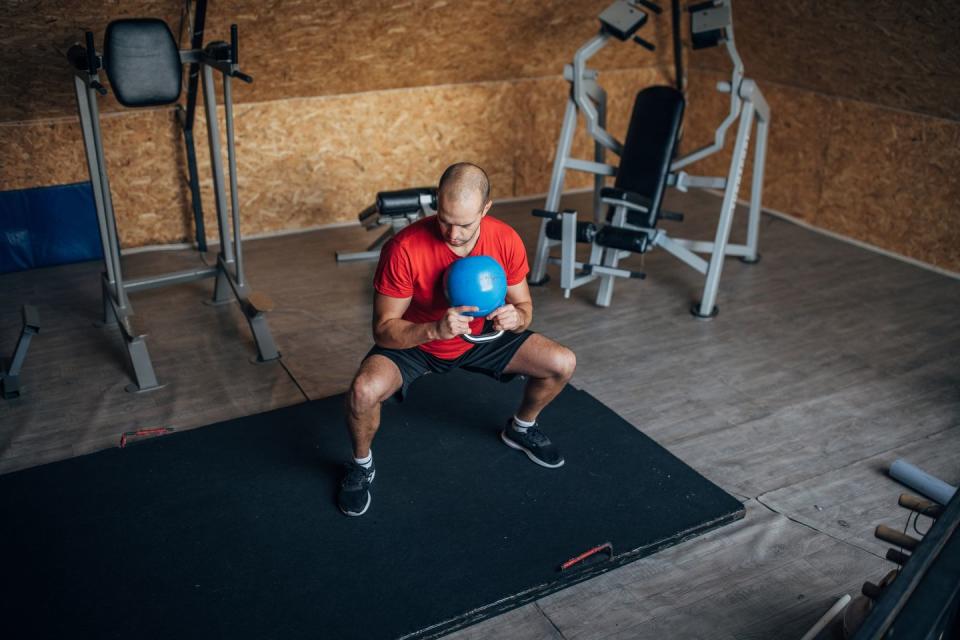
Benefits of the Sumo Squat
Target the Adductors
Sumo squats have a wider stance and a turned-out foot position. You can target the adductor muscles (inner thighs) more than regular squats.
Target the Glutes
The wider stance and foot position places greater emphasis on the glute muscles, particularly the gluteus maximus. This can help power up your other lifts like deadlifts and kettlebell swings.
Hip Mobility
The deep range of movement required for sumo squats significantly benefits hip mobility, thanks to the increased external rotation of the hip joint. This exercise offers a double advantage, enhancing both mobility and strength, making it a highly effective addition to any workout routine.
Less Stress on the Lower Back
The upright position of the sumo squat means that more work is placed on the legs rather than the lower back. With the right load, this can be more suitable for those who struggle with lower back issues.
Heavier Weight Lifted
Due to the nature of the foot stance being wider, your torso is slightly lower to the ground in comparison to regular squats. This means that with reduced range of motion, you may find you can lift more weight.
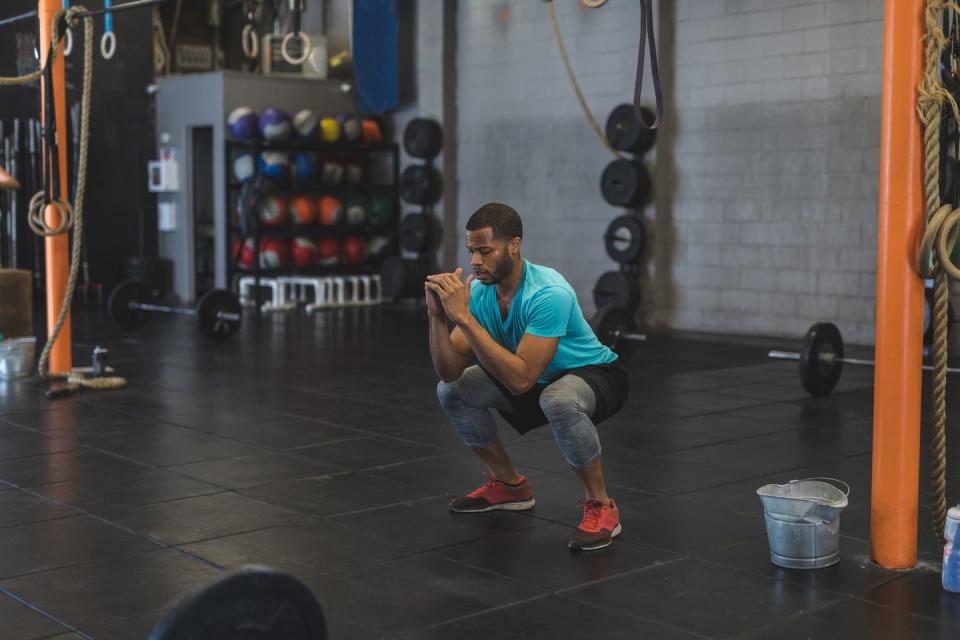
5 Sumo Squat Workouts
Set Your Quads and Hamstrings Ablaze With One Dumbbell Using This ‘21’s’ Workout
The Men’s Health Dumbbell Club – Weekly Workouts for a Fitter, Stronger Body
Hit Your Legs Hard with This 350-Rep Leg Burner That Only Requires One Dumbbell
The Men’s Health Dumbbell Club – Your Weekly Three Day Plan for Muscle and Fitness
Hit This Cover Model-Approved Leg Workout for Bigger Quads, Stronger Glutes and Harder Abs
How to Do the Sumo Squat
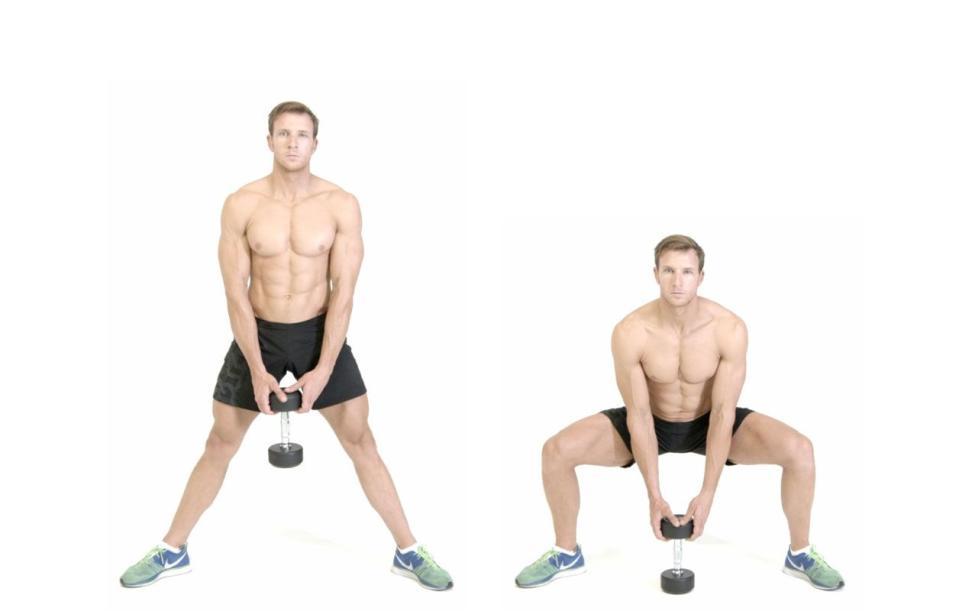
Stand with your feet slightly turned out and wider than shoulder-width apart, holding a dumbbell or kettlebell. Choose a foot position that suits your mobility and feels comfortable.
Sit your hips back while keeping your chest upright.
Hit at least parallel while tracking the knees over the toes.
Engage the glutes to ensure your knees don't fall inwards.
Drive your heels into the floor to push yourself explosively back up to the start position.
Sumo Squat vs Regular Squat
So, what's the difference between a sumo squat and your regular squat? Here are the main differences you'll find between the two techniques:
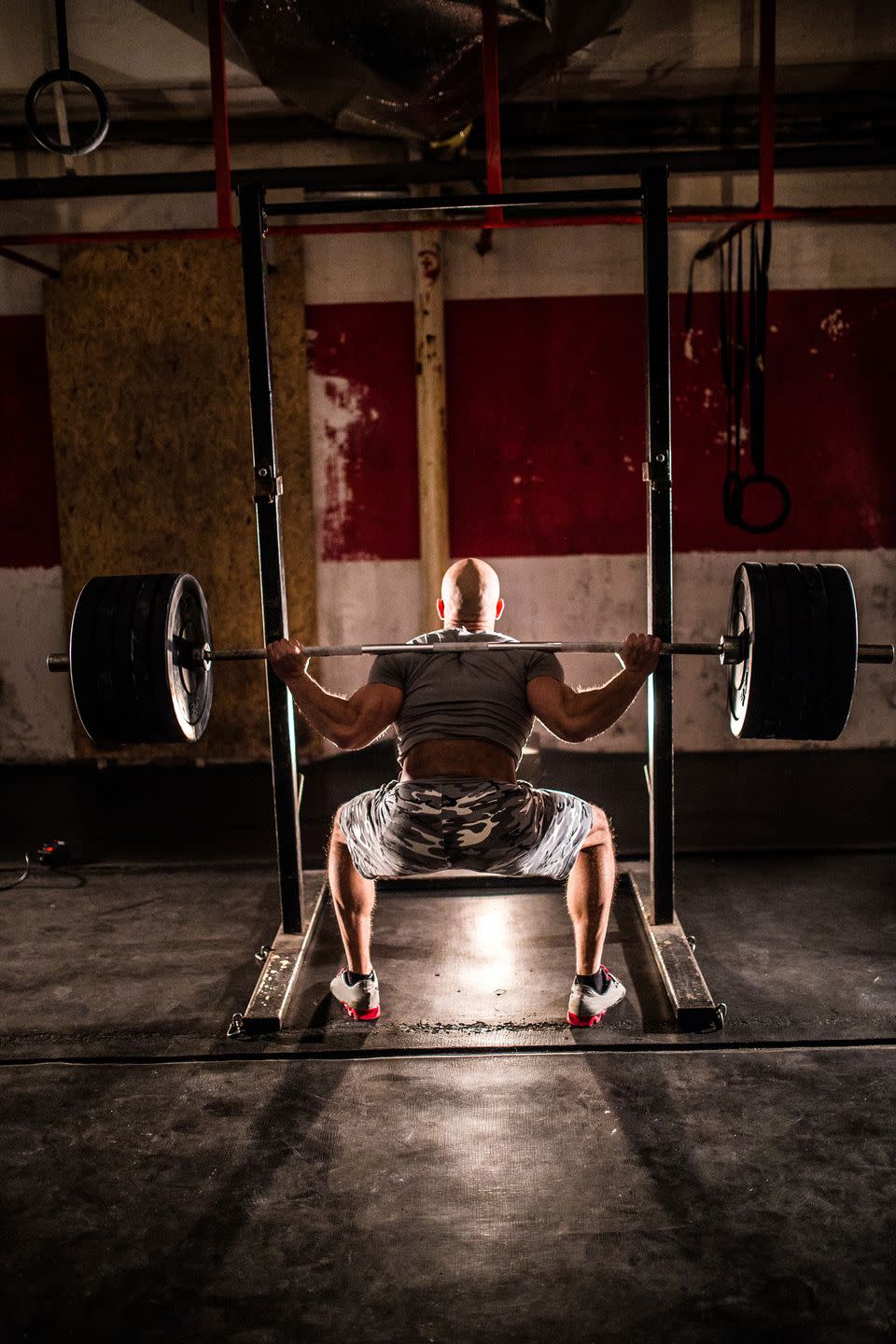
Foot position: The sumo squat has a much wider foot stance than the regular squat, typically with the feet turned out, wider than shoulder-width.
Muscles worked: This wider foot stance places greater emphasis on the glute and adductor muscles, whereas the standard squat stance targets the quads more.
More hip mobility required: The sumo squat requires more hip mobility than the standard squat. The move will stretch the groin and require more external rotation of the hip joint.
Less range of motion: The sumo squat tends to have a very slightly reduced range of motion in comparison to regular squats. This means you may get away with lifting a little heavier or finding your usual weight a little easier.
5 Sumo Squat Variations

Goblet Squat
How:
Stand with your feet a little wider than your hips and hold your kettlebell close to your upper chest either by the handle or upside down.
Keep your chest proud and your core locked.
Sink your hips back and descend into a squat while the knees travel in line with the toes.
At the bottom of the squat, the thighs should hit parallel or lower and your elbows should come in between your knees.
Drive back up, through the heels and tense your glutes at the top. Repeat.
Why: Goblet squats are a great place to start if the sumo squat is a little wider than your hip mobility will allow. The positioning of the weight will aid hip mobility so that you can transition to sumo squats after mastering the more narrow position.
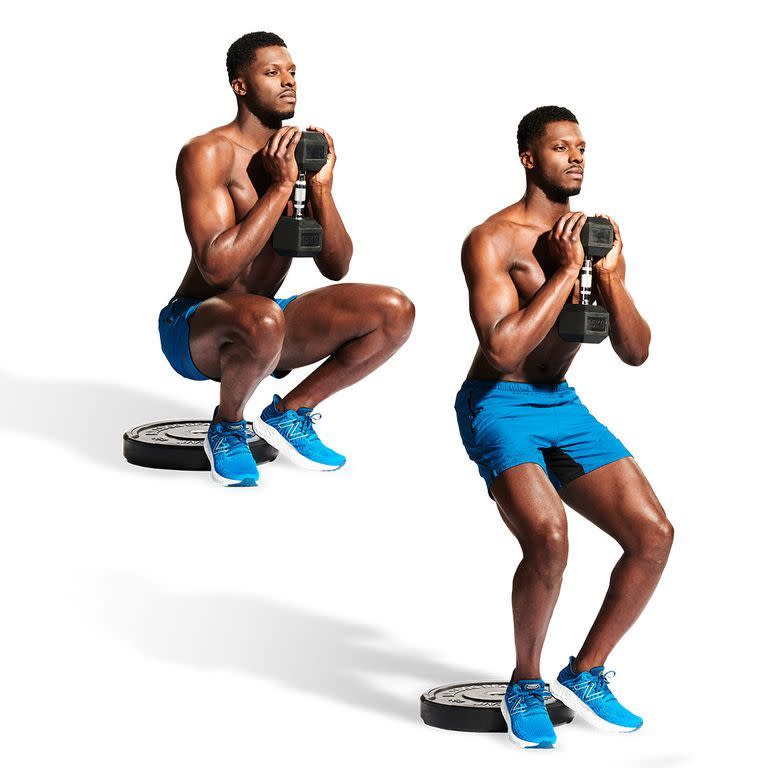
Cyclist Squat
How:
Raise your heels up on a weight plate or block, keeping your feet within six inches of each other, heels close together.
Hold your dumbbell close to your chest.
Squat down until your thighs pass parallel to the ground, stand up explosively, stopping just short of locking your legs out to keep the tension on the quads. Repeat.
Why: Mixing up your sumo squats with cyclist squats can mean you work the entirety of your lower body. Cyclist squats overload the quads, whereas the sumo squats primarily work the glutes, so putting them in a superset together could be the secret sauce your leg day needs.
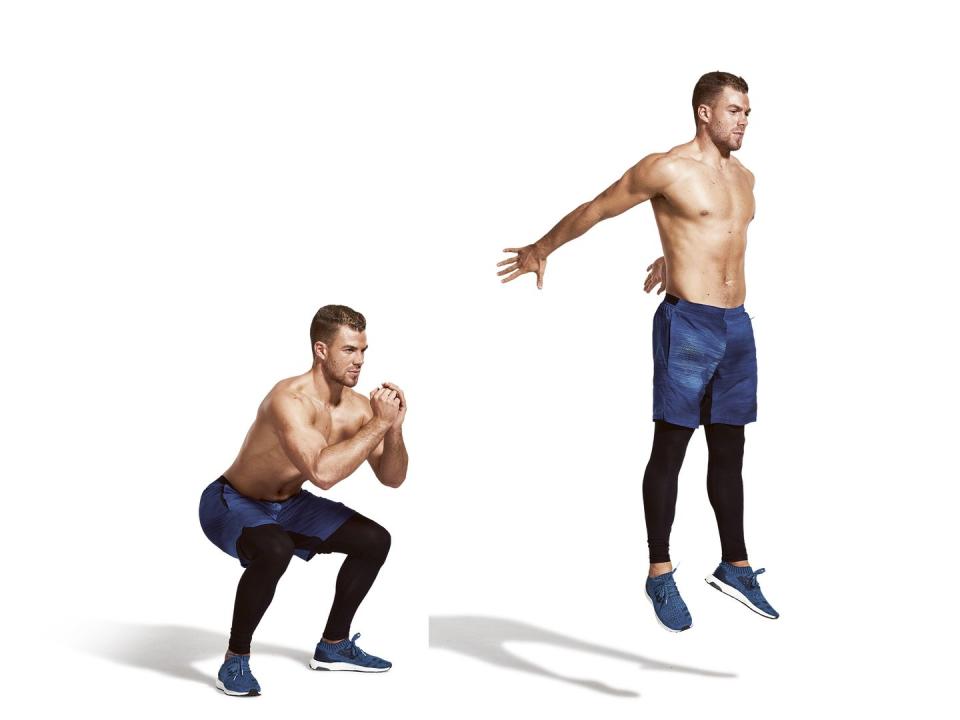
Jump Squat
How:
From standing, with your feet at shoulder-width, bend your knees slowly to drop into a full squat. Try to keep your lower back flat at the bottom.
Jump up. As you land, control your descent and slowly return to the squat position.
Why: For some additional plyometric work in your training for explosive power, include jump squats. Complete them with as much air time as possible.
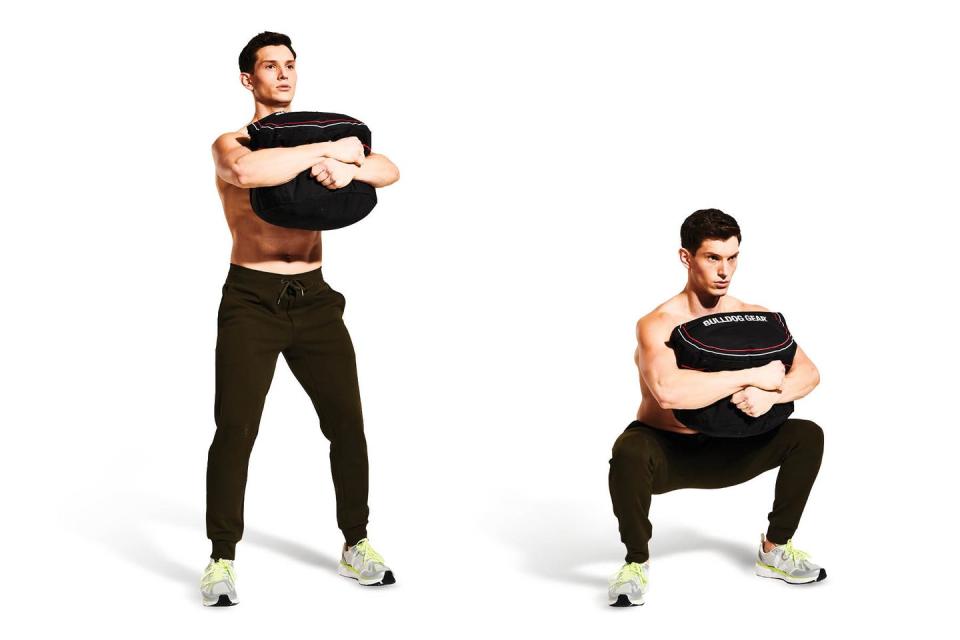
Sandbag Squat
How:
With the bag standing tall, squat down and wrap your arms around it. 'Hug’ the bag as tightly as possible before standing upright, the bag should be covering your entire torso.
Squat down until the crease of your hip passes your knee before returning to standing. Maintain an upright posture and tight squeeze on the bag throughout.
Why: Sandbag squats encourage an upright tall torso, something necessary for sumo squats. These are great for leg day finishers and circuits.
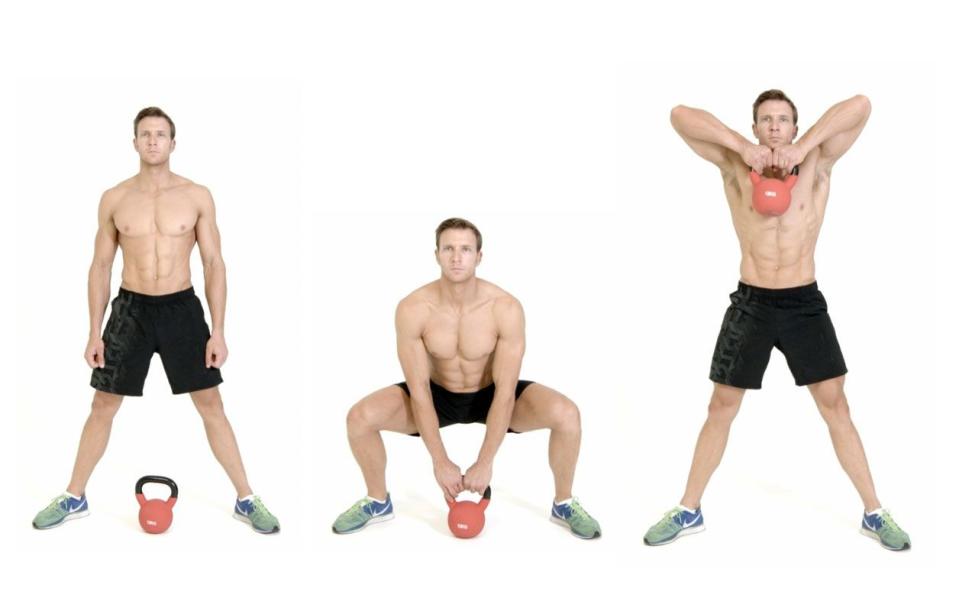
Sumo High Pull
How:
Stand with your legs wider than shoulder-width and place a kettlebell between them.
Lower your body into squat position until your knees are bent and both hands reach the kettlebell.
Extend through your legs and raise the kettlebell to your chin, so your arms bend and elbows are high. Squat down and repeat.
Why: To add some shoulder and trap work to your sumo squats, add the high pull. This will upgrade the movement so that it raises your heart rate and works the entire body.
You Might Also Like


